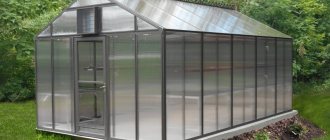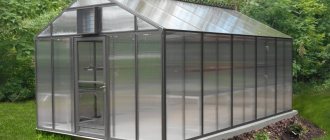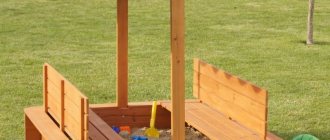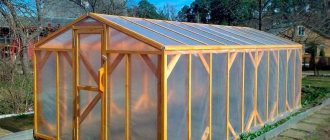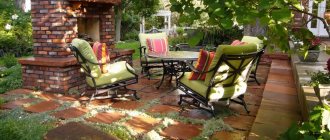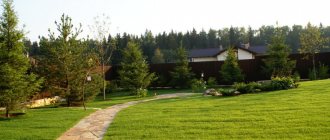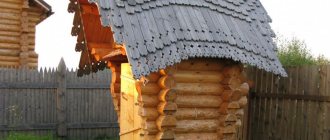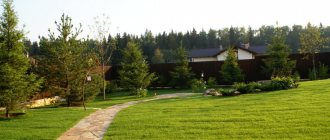Features of installation of warm greenhouses
Depending on the purpose of the greenhouse, the method of its heating, the level of illumination and other technical characteristics are selected. Winter greenhouse structures are buildings on a foundation that can withstand strong gusts of wind and snow loads.
First, you need to decide on the place where the winter greenhouse with heating will be installed with your own hands. It could be a hillock or a hill. If the terrain is flat, then it is advisable to create an earthen embankment. This method contributes to additional heating of the greenhouse building due to the sun.
It is advisable to allocate an area for a vestibule within the building area. It will create a transition zone and cold air will not penetrate to the planted plants.
Construction sequence
There is no universal sequence for constructing a greenhouse, since in each case it is determined by many factors. Usually, a foundation for a winter greenhouse (if necessary), a frame, and then sheathing are built.
The most important stage is the cladding. Before it you need to take accurate measurements. Also, do not forget about the heating system and ventilation.
Foundation
The greenhouse building has a heavy structure and requires laying a foundation for strength. There are 4 ways to base it:
- tape;
- brick;
- squared;
- stone foundation.
Practice shows that the most common is a strip foundation.
Work order:
- Construction site marking;
- digging a ditch about a meter deep;
- covering the bottom of the pit with waterproofing;
- production of reinforcement to strengthen the foundation;
- filling the ditch with cement mortar;
- coating of thermal insulation material on a completely hardened foundation.
Next, bolts are attached to the prepared foundation to construct the frame. When deciding how to build a winter greenhouse, some craftsmen lay one layer of brick on the foundation. With this method, the bolts must pass through the brickwork and penetrate the fabricated foundation.
What buildings are suitable for a winter garden?
It is important to choose a durable frame
There are many design options for a winter greenhouse. This is not surprising - relatively light structures are suitable for the southern regions, but in the central and northern regions such a shelter usually looks like a permanent building with a deep foundation, a high base and a strong roof. The type is determined by several parameters:
- Location. There are three options - deep into the ground, above ground and superstructures (winter gardens and greenhouses in attics).
- Heating. According to the type of heating, greenhouses are equipped with biofuel, technical heating and solar heating (solar greenhouses).
- Architecture. Here everything is limited only by the designer’s imagination - single- and double-slope, geodesic, arched, wall-mounted. The main thing is that the design retains heat well and is comfortable to work in.
- Functionality. The choice of building materials (wood, brick, glass, film, polycarbonate), the internal arrangement system and the types of beds depend on what you plan to grow.
Frame
For the construction of the frame, pipes, angles and metal profiles are mainly used.
Stages of work:
- Fastening the bottom lining to the manufactured foundation with anchor bolts;
- installation of vertical supports on the lining using fasteners or a welding machine;
- joining vertical posts with a horizontal support at the top;
- installation of the frame under the roof.
To increase the strength of the created structure, the profiles are joined with stiffeners. Next, the finished frame is sheathed with polycarbonate.
The strength of the greenhouse structure as a whole depends on the proper design of the frame. Therefore, it is installed based on plans and calculations prepared in advance.
Construction Materials
Another classification of greenhouses depends on the materials used - it can be brick, wood, metal profile, polycarbonate and glass. A combination of several in one building is also possible.
It is worth selecting based on several criteria, such as the chosen design, weather resistance, physical activity, cost and service life.
A glass greenhouse is the most classic option. They transmit light well and retain heat. Despite this, the popularity of this material is falling - the market is being replaced by new, lighter, cheaper and stronger products.
A polymer greenhouse will also transmit light well and will not require much effort to install. But, it is worth taking into account the formation of excess moisture - ventilation is required. Also, this material will quickly lose its appearance.
Glass and film are very successfully combined in cellular polycarbonate. This material has excellent properties, which are just suitable for building a greenhouse for the winter.
Types of winter greenhouses
Depending on the frame material, the shape of the greenhouse is selected. They can be arched, single-pitched or gable-shaped. Arched types are usually used for a metal frame.
This is due to the fact that it is problematic to make an arched greenhouse from a wooden frame. It will take a lot of effort and time. But for wooden structures, single-slope and gable types of greenhouses are acceptable.
Sheathing
The era of multilayer PVC film is becoming a thing of the past and has been replaced by polycarbonate, from which the best winter greenhouses are made. The material has many advantages:
- Aesthetic appearance;
- resistance to external damage;
- ease of processing and installation of sheets;
- a light weight;
- polycarbonate can withstand increased loads;
- does not deform under the influence of ultraviolet rays.
The listed characteristics make polycarbonate an excellent material when deciding how to make a winter greenhouse. It ideally protects plantings from precipitation in the form of rain and snow. Helps maintain the desired microclimate. The photo of a winter greenhouse shows a version of a polycarbonate greenhouse.
Glass also continues to be used as cladding. It is inferior to a winter greenhouse made of polycarbonate in terms of thermal conductivity, but with careful handling it wins in terms of long service life and light transmission.
In regions with cold climates, the best option is a greenhouse - a thermos. Its essence lies in double sheet cladding like a double-glazed window. The characteristics of the outer layer are 6 mm, and the inner layer is 4 mm.
When to plant winter vegetables
Most of the vegetables in my winter greenhouse are planted from mid-summer to mid-autumn. Ideally, the crop should be nearly ripe or ready to harvest as soon as the weather turns cold and day length drops below ten hours per day. It is at this point that the growth of most plants slows down sharply. In my northern climate, this date is early November and the ripe or nearly ripe vegetables remain in the greenhouse until we are ready to harvest. To determine the correct planting date, you need to look at the days to maturity for an individual crop or variety. This information is included in the seed packet or seed catalog. My carrot crop in Naples, for example, takes about 58 days to go from seed to harvest. So ideally I would count back 58 days from my first expected frost and planting date. However, as day lengths shorten in the fall, plant growth slows, so I always add an extra 7-10 days when planting crops for late fall and winter harvests. This means I end up sowing Napoli carrots for winter in mid-summer. Salad greens such as arugula, lettuce and spinach grow faster than root vegetables and are sown in late summer to early fall. They can be sown directly or given a head start indoors under growing lights. If you want to have mature cabbage or kale plants for winter harvests, they take about 70 days from planting, so plan accordingly.
To further insulate my winter crops, I often erect fabric-covered mini-hoop tunnels over raised beds. It helps trap heat and protect vegetables from cold weather.
Heating
With a variety of methods and fuel used, there are several heating options:
Air - heated air moves through different level air ducts or is heated by a stove installed in the house. It is one of the most budget-friendly options for heating a winter greenhouse. A significant disadvantage of this option is manual control. Accordingly, according to safety regulations, it is impossible to leave such a greenhouse without control.
Contour - an electrothermal circuit is mounted along the edges, a radiator and pipes are used.
Subsoil - suitable for use in regions with warm climates. Water floor tubes or special electrical cables used for subsurface heating are laid directly in the ground.
Combined - a combination of infrared lamps for greenhouse conditions on top and polypropylene tubes filled with coolant located in the soil. The overall operation of the two elements of the system contributes to uniform heating of the air in the lower part of the greenhouse and in its upper part. This heating system is equipped with microclimate control sensors in a heated winter greenhouse.
Passive solar greenhouse, Invermere, Canada
The design of this greenhouse is very atypical: it has an insulated back wall and roof. There is also a complex of high- and low-tech systems installed here, thanks to which such a greenhouse can be used in cold, sunny climates.
The greenhouse designers decided not to build a “transparent box” and abandoned the north-facing glass wall to avoid heat loss and lack of light. Instead, they built a concrete thermal storage wall and floor, and insulated the back wall and ceiling to keep the heat in the room.
Another special feature of the greenhouse is that it has a geoinformation energy saving system installed, with the help of which heated air moves from top to bottom and is directed into the ground under the greenhouse. This air can then be returned back and used to heat the greenhouse.
Lighting and Humidity
For full development, plants require additional lighting. The level of lighting depends on the crops planted in the greenhouse. In particular, greens and young seedlings require less light, unlike berry crops.
For lighting, sodium lamps are installed that imitate the sun's rays. Lamps are mounted above beds or boxes with seedlings. You can also hang regular fluorescent lamps. But in terms of efficiency they are much inferior to sodium lamps.
It is important to equip electrical wiring with moisture protection.
Regular watering eliminates the need for additional air humidity. To avoid excessive humidity, create a forced exhaust or ventilate the greenhouse through the vents on the roof. Irrigation is organized using warm underground water supply or using storage tanks.
To build a winter greenhouse you will not need to spend a lot on building materials. As a result, it will last for many years and will be an excellent help in the garden, and fresh fruits and vegetables grown yourself will create a good mood.
Preparatory work
Preparing for the construction of a winter (year-round) greenhouse with your own hands includes planning, preparation of materials, preparation for heating installation and arrangement of the foundation.
Planning
There are many options for winter greenhouse designs. They can be a traditional, quadrangular shape in the top view, but they can also be hexagonal , they can be of different heights , ventilated differently, etc. The easiest way is to take as a basis the design of a quadrangular (sometimes they say four-walled) greenhouse , and here's why:
- personal plots and vegetable gardens usually have a quadrangular shape; by arranging the greenhouse according to the shape of the vegetable garden, you rationally use the space ;
- A four-wall greenhouse design for winter growing is simpler . Especially when glazing or stretching film;
- To service such a greenhouse, you can draw a single path in the middle, along which pipes for irrigation, etc. will be directed. That is, it is easier to operate .
Hexagonal (octagonal, decagonal) greenhouses usually have modest dimensions and the advantage that the hexagon has a more favorable ratio of area and perimeter, hence less heat loss , but the complexity of the design and the complexity of operation, the limitation in size makes such greenhouses more of a work of art than a means to earn money or grow plants for food. Therefore, we will consider a quadrangular greenhouse.
Fig.3 Hexagonal greenhouse
It should be oriented from north to south, it is best to make the roof gable , and install additional supports so that the structure does not collapse under the weight of snow. If the frame is factory-made and the cross-section of the greenhouse has the shape of an arch, this is even better - the snow will slide off on its own.
The place should be level, the soil should be sandy . If it is clayey, you need to make a cushion of sand, and on top - a layer of fertile black soil.
Ventilation must be carried out regularly during the warm season , otherwise the plants will die from the heat. This means that this function needs to be included in the design. Firstly , the greenhouse must have two doors at opposite ends to create a draft when they are opened simultaneously. Secondly , if the greenhouse is more than 10 meters in length, it is desirable that it also have opening windows . Windows can be in the side walls, the ceiling, next to or above the doors. The higher the windows, the better.
Materials
Here , the stronger, the better . A steel angle or pipe is best. A factory frame made of galvanized iron is suitable. Bolt together.
Worse - timber, board or poles. It is better to fasten wood with self-tapping screws; nails are often pulled out by the wind, especially when the wood begins to collapse.
It is advisable to paint non-galvanized iron so that it rusts less, and treat wood with an antiseptic to prevent fungi or insects from infesting it.
Foundation structure
This mandatory part of the winter greenhouse must reach such a depth where the ground no longer freezes . The foundation may consist of cinder block or concrete. It must be insulated on top with waterproof material (tar paper) so that moisture does not rise higher.
On the foundation there must be a plinth , which is built from the same cinder block or brick. In this case, the floor of the greenhouse can be lower than the level of the surrounding soil , i.e., year-round greenhouses made with your own hands are, as it were, dug into the ground for better heat retention.
Heating preparation
For large greenhouses, the best heating is water , like in a house. This will allow the heat to be evenly distributed. But this requires a lot of money, materials and labor, so it will be easier to make several ordinary potbelly stoves . For a potbelly stove to be more efficient, the pipe from it should not go vertically upward. Instead, make 5 meters of pipe at a slight angle (up to 10 degrees), and then connect it to a vertical pipe.
Be careful that there are no smoke leaks at the joints - it is harmful to plants because it contains sulfur oxides.
Fig. 4 Example of heating in a winter greenhouse
There are also infrared gas burners , which will serve as an additional source of heat. But they need to be screened from the ceiling and from plants. It is best to place such a burner inside a large pipe, open on both sides. The combustion products of natural gas are almost harmless to plants , unlike the combustion products of wood and coal.
